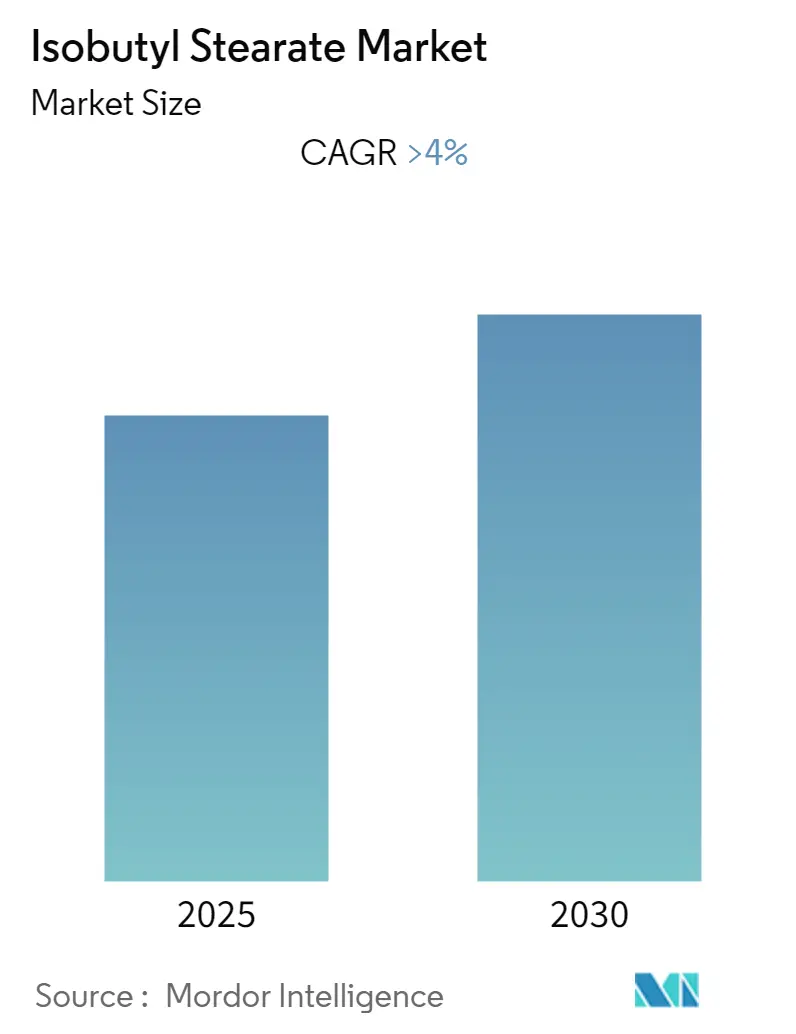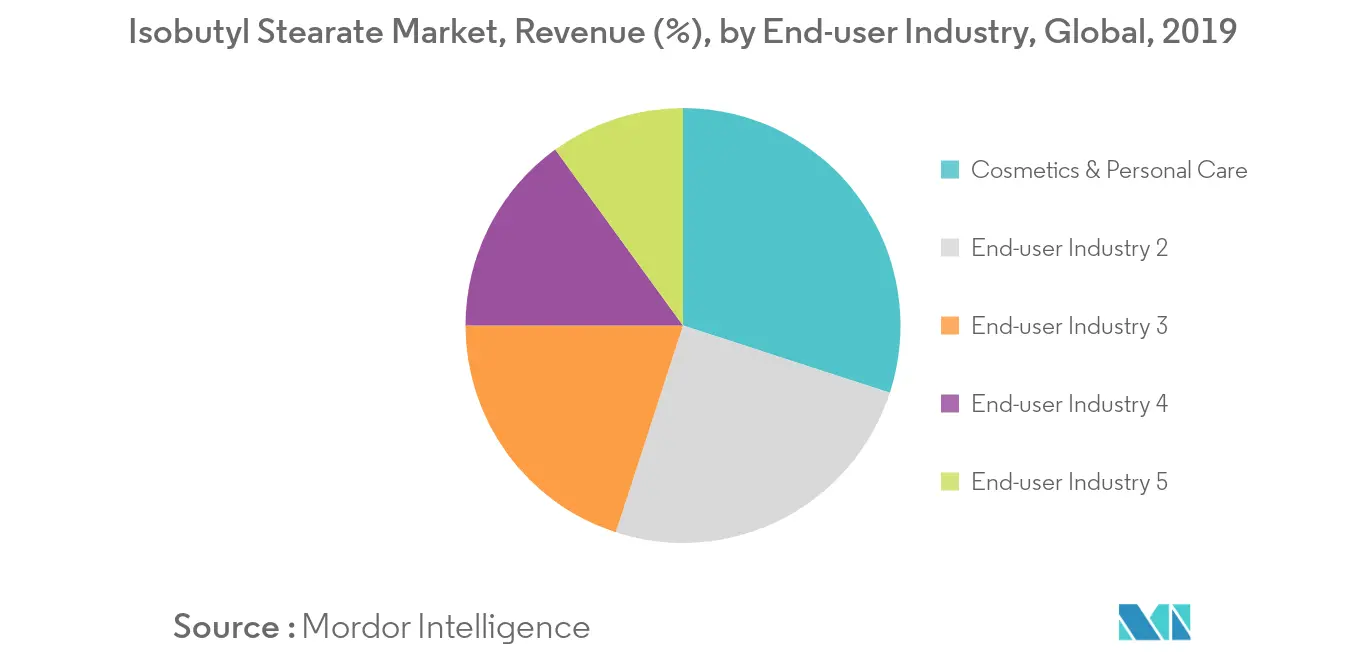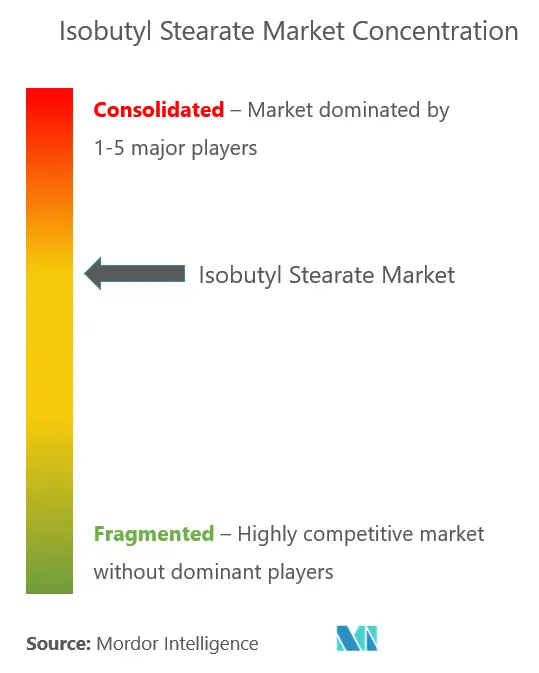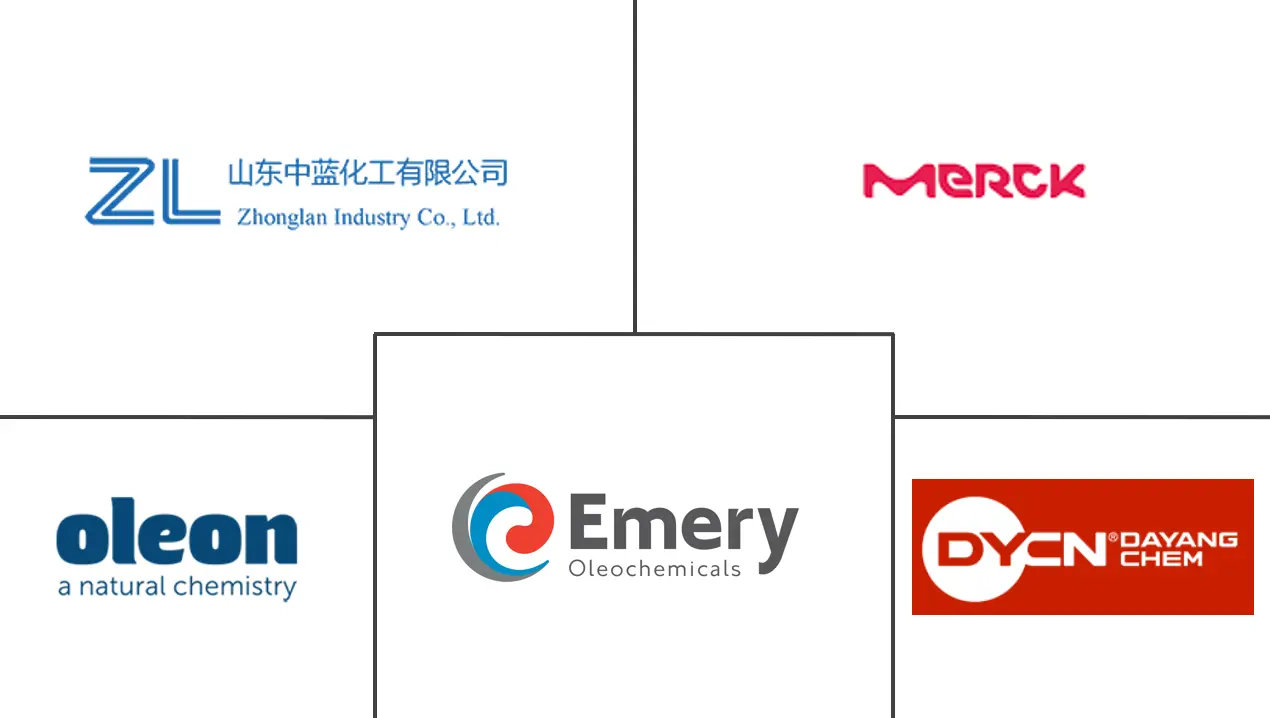Isobutyl Stearate Market Size and Share

Isobutyl Stearate Market Analysis by Mordor Intelligence
The Isobutyl Stearate Market is expected to register a CAGR of greater than 4% during the forecast period.
- The cosmetics & personal care industry is expected to dominate the global isobutyl stearate market over the forecast period.
- Asia-Pacific region represents the largest market and is also expected to be the fastest-growing market over the forecast period owing to the increasing consumption from countries such as China, India, and Japan.
Global Isobutyl Stearate Market Trends and Insights
Increasing Demand from Cosmetics & Personal Care Industry
- Major applications of isobutyl stearate in the personal care & cosmetics industry are in polishes, face creams, rouges, ointments, soaps, etc. They are also used in skincare as skin conditioning agents, i.e., emollients. The global personal care & cosmetics industry is anticipated to grow at a CAGR at about 6%, during the forecast period.
- Continuous increase in online beauty spending, expansion of social networks, consumers' interest in new, different and premium products, acceleration of urbanization worldwide, and growth of the upper-middle classes all over the world and especially in Asia, where consumers are both knowledgeable and enthusiastic about this segment, are some of the major factors that contribute to the steady growth of the cosmetics and personal care market.
- Top 10 countries exporting the highest value worth of cosmetics and skincare products during 2019 were France (16.3% of total beauty/skincare goods exports), United States (9.9%), Singapore (8.8%), South Korea (8.4%), Japan (6.6%), Germany (6.5%), Hong Kong (4.3%), China (4.2%), Italy (3.9%), and United Kingdom (3.8%). Some of the largest global cosmetic companies which manufacturing bases in the above countries, are Johnson & Johnson, L'Oreal Paris,Gillette, Neutrogena, Nivea and Chanel, Inc.
- The personal care and cosmetics industry represents the largest market over the forecast period, owing to the cosmetics and personal care products becoming an essential part of consumer's everyday life.
- However, demand for isobutyl stearate from the industry segment is expected to grow moderately, owing to global supply-chain disruptions and production shutdowns due to the COVID-19 pandemic.

Asia-Pacific Region to Dominate the Market
- Asia-Pacific region is expected to be the dominant market in isobutyl stearate consumption. This is because the region dominates the market for end-use industries such as cosmetics & personal care, pharmaceuticals, textile, etc.
- The Asian cosmetics & personal care market is gaining popularity worldwide and is expected to grow at a CAGR of more than 5%, during the forecast period, with Japan, Singapore, South Korea, Hong Kong, and China being amongst the top 10 global cosmetics exporters. In cosmetics, isobutyl stearate is used most frequently in the formulation of eye makeup, skin makeup, lipstick and skincare products.
- For personal care products, where isobutyl stearate is heavily used in personal care products like soap, shampoo, creams, lotions, etc., China generates maximum revenue, globally.
- Isobutyl stearate is also used in topical pharmaceuticals. The Asia-Pacific pharmaceutical market is the third-largest pharmaceutical market in the world after North America and Europe, owing to the size of the population, especially the older population, GDP per capita, health expenditures, and regulatory systems, among others.
- In textile manufacturing, countries such as Vietnam, Bangladesh, China, India and Hong Kong stand out amongst the top 10 global manufacturers, hence, indicating regular demand for isobutyl stearate to be used as a lubricant for textile processing.
- Thus, rising demands from the above-mentioned end-user industries is expected to drive the growth in the Asia-Pacific region.

Competitive Landscape
The global isobutyl stearate market is partially consolidated. The major companies include Emery Oleochemicals, Hangzhou Dayangchem Co., Ltd., Merck KGaA, Oleon NV and Zhonglan Industry Co.,Ltd., among others.
Isobutyl Stearate Industry Leaders
-
Emery Oleochemicals
-
Hangzhou Dayangchem Co., Ltd.
-
Oleon NV
-
Merck KGaA
-
Zhonglan Industry Co.,Ltd.
- *Disclaimer: Major Players sorted in no particular order

Global Isobutyl Stearate Market Report Scope
The Isobutyl Stearate Market report includes:
| Cosmetics & Personal Care |
| Pharmaceuticals |
| Textile |
| Rubber |
| Others |
| Asia-Pacific | China |
| India | |
| Japan | |
| South Korea | |
| Rest of Asia-Pacific | |
| North America | United States |
| Canada | |
| Mexico | |
| Europe | Germany |
| United Kingdom | |
| Italy | |
| France | |
| Rest of Europe | |
| South America | Brazil |
| Argentina | |
| Rest of South America | |
| Middle-East and Africa | Saudi Arabia |
| South Africa | |
| Rest of Middle-East and Africa |
| End-user Industry | Cosmetics & Personal Care | |
| Pharmaceuticals | ||
| Textile | ||
| Rubber | ||
| Others | ||
| Geography | Asia-Pacific | China |
| India | ||
| Japan | ||
| South Korea | ||
| Rest of Asia-Pacific | ||
| North America | United States | |
| Canada | ||
| Mexico | ||
| Europe | Germany | |
| United Kingdom | ||
| Italy | ||
| France | ||
| Rest of Europe | ||
| South America | Brazil | |
| Argentina | ||
| Rest of South America | ||
| Middle-East and Africa | Saudi Arabia | |
| South Africa | ||
| Rest of Middle-East and Africa | ||
Key Questions Answered in the Report
What is the current Isobutyl Stearate Market size?
The Isobutyl Stearate Market is projected to register a CAGR of greater than 4% during the forecast period (2025-2030)
Who are the key players in Isobutyl Stearate Market?
Emery Oleochemicals, Hangzhou Dayangchem Co., Ltd., Oleon NV, Merck KGaA and Zhonglan Industry Co.,Ltd. are the major companies operating in the Isobutyl Stearate Market.
Which is the fastest growing region in Isobutyl Stearate Market?
Asia Pacific is estimated to grow at the highest CAGR over the forecast period (2025-2030).
Which region has the biggest share in Isobutyl Stearate Market?
In 2025, the Asia Pacific accounts for the largest market share in Isobutyl Stearate Market.
What years does this Isobutyl Stearate Market cover?
The report covers the Isobutyl Stearate Market historical market size for years: 2019, 2020, 2021, 2022, 2023 and 2024. The report also forecasts the Isobutyl Stearate Market size for years: 2025, 2026, 2027, 2028, 2029 and 2030.
Page last updated on:
Isobutyl Stearate Market Report
Statistics for the 2025 Isobutyl Stearate market share, size and revenue growth rate, created by Mordor Intelligence™ Industry Reports. Isobutyl Stearate analysis includes a market forecast outlook for 2025 to 2030 and historical overview. Get a sample of this industry analysis as a free report PDF download.



